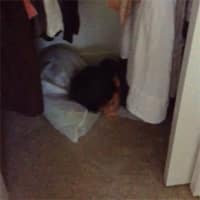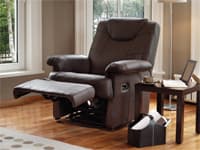
Bedding Posts
Keep up to date on news and trends in the bedding industry on the Factoring 101 Blog.
Jump to a Post
Where does your kid sleep?
After my two year old son took a nap on a pile of clothes in my closet this afternoon, it made me think, where do most kids sleep after they leave the crib? It turns out that twin sized beds are by far the most popular size bed for any age group with four out of every ten kids sleeping in a twin size bed according to research by Kids Today.
Twin size beds are especially popular for younger children. After that, full size beds come next with 20% of all children sleeping in them. Of course these numbers tend to shift as children get older. By the age of 12, 30% of all children are sleeping in full size beds, while twin size beds only appear in 37% of children's rooms. While at the age of 15, only 29% of children sleep in twin size beds, but full size beds don't gain any of the market with teens, instead 11% of teens sleep in queen size beds. Only about 5% of younger kids will sleep in a queen size bed.
The other type of bed that is popular among all ages of children is the bunk bed. While not quite as popular with children under 2 or over 12, with only 11% sleeping in bunk beds. Around 15% of children between 2 and 11 will sleep in a bunk bed, including my son when he's not busy sleeping in closets!
Also popular are trundle beds and loft beds which hold a combined 10% of all children at bedtime, with trundle beds more popular with the younger kids, and loft beds more popular with older kids. The only other bed that is popular is the toddler bed which holds about 11% of all children under the age of 2, but pretty much no children after that.
Moving beyond the size of the bed, most parents prefer to buy their children more traditional beds over beds that have a more kid-friendly style, especially as the parents get older. For parents under the age of 35, only a third of parents will get their kids a bed with a kid-friendly design. For parents 45 and up, less than a quarter of them will get their kids a bed with a kid-friendly design.
The other important factors in choosing a bed for your child is what its made of and where its made. Most parents prefer to buy solid wood beds. For families making over $50,000 a year, 6 out of 10 parents plan to buy their kids a solid wood bed. But even more important than what its made from is where it is made. Most parents believe that it is very important to buy a bed that is made in America, especially as children get older. Three quarters of all parents with children over the age of 15 find it important to have a bed that is made in America.
When it comes to case goods, 83% of parents are likely to purchase matching case goods at the same time that they buy their child a bed. In fact, 27% of parents say that they are very likely to do this. This number increases among more affluent parents and parents in the Northeast. 38% of all families making $100,000 or more a year say that they are very likely to buy matching case goods, while 37% of parents in the Northeast also say they are very likely to purchase matching case goods.
With $5.7 billion spent on kids furniture in 2014, it is important to know who exactly is buying this furniture. When it comes to beds, it is almost always the child's parents. For families making less than $50,000 a year, 78% of the beds are purchased by the parents, with 20% purchased by grandparents. For families making over $50,000 a year, 87% of beds are purchased by the parents with only 10% being purchased by grandparents.
If you are a manufacturer or importer of children's furniture it is important to keep up with the current trends in the industry. Let DSA Factors help you out by factoring your accounts receivable. Let us use our experience to handle all the credit checking and collection work, while also improving your cash flow and insuring your receivables. You have more important things to worry about, why waste time worrying about receivables.
Where do you buy your bedding?
There are a large variety of types of stores selling furniture these days, but when it comes to bedding, how old you are probably determines where you shop. A recent study in Furniture Today revealed which generations purchase bedding at different types of stores. Overall, Millennials and Generation X each have a 35% share of the market, while Baby Boomers have a 26% share, and Seniors a 4% share.
Bedding specialty stores get a large variety of customers, but they also tend to have the highest prices with the price of their average queen set costing $699. As a result Generation X makes up their largest share of customers at 37%, followed by Baby Boomers at 34%, Millennials at 23%, and Seniors at 6%.
Traditional furniture stores also seem to receive a fairly evenly distributed clientele. While not as expensive as bedding specialists, their prices are still up there with the average queen set costing $599. Millennials make up their largest share at 36%, followed by Baby Boomers at 33%, Generation X at 30%, and Seniors at 1%.
Beyond these two types of stores, things get a little more lopsided. There are the manufacturer branded furniture stores whose average queen set costs $599, department stores where the average queen set costs $499, warehouse membership clubs have the average queen set at $479, online retailers where the average queen set is $325, discount department stores where the average queen set is $275, and finally lifestyle furniture stores where the average queen set will only set you back $155.
It should come as no surprise that Millennials prefer to shop at the cheaper places. They hold a 58% share of sales at lifestyle furniture stores such as IKEA, a 43% share at discount department stores such as Walmart, and a 59% share at online retailers such as Amazon. But what may surprise you is that they also hold a 53% share at the pricier manufacturer branded furniture stores such as Ashley Home Stores.
Generation X prefers to shop at department stores such as Macy's where they hold a 55% share of the business. They also hold a 43% share at warehouse membership clubs such as Costco, a 40% share at discount department stores, and a 31% share at manufacturer branded furniture stores.
Baby Boomers do most of their shopping at the bedding specialty store and traditional furniture stores. Warehouse membership clubs are next, but only 21% of their business comes from Baby Boomers.
For Seniors who only hold a 4% share of the overall market, they take a large 14% share of business at warehouse membership clubs. They also hold a 7% share of the business at department stores.
If you are targeting your mattresses towards a certain demographic, make sure you are selling to the stores they shop at. If you need help selling to those stores, give DSA Factors a call today at 773-248-9000 and with our accounts receivable factoring you can get paid today for your net 30 day invoices.
What's in a Mattress?
Walk into any mattress or furniture store and one of the first things you'll see is a cutaway corner of a mattress showing you the innersprings or foam that make up the mattress. Stay a little longer and the salesman will start explaining to you about memory foam and innersprings and gel. They love to talk about gel and how it will keep you cooler at night. But is this really what you want to hear about? Do you even know what gel is?
According to a recent poll by Furniture Today, only 31% of consumers say that the construction materials of their mattress are important to them. While most people do want to know what their mattress is made of, its really more out of curiosity than out of actual interest. Yet construction materials is something that these stores always stress and show in their advertising.
For the most part consumers don't really know a whole lot about construction materials, and why should they, all they really want is a good night's sleep. Consumers are much more concerned with more practical aspects like sleep, comfort, durability, and support. These are the things that really matter to them, after all, it doesn't really matter how many springs or how much gel is in your mattress if you can't get a good night's sleep on it.
However, according to research, 31% of bedding specialists always feature construction material in the advertising while 69% of them always talk about it on the sales room floor. For those that don't always tout the materials, they all say that they sometimes tout the materials. These numbers go down a bit when you move to furniture stores. Only 9% of furniture stores always feature materials in the advertising, while 35% of them never feature materials. When you get to the sales floor only 54% say they always tout the materials, with the rest saying that they only sometimes tout the materials.
According to Bob Muenkel, director of sales education and development at Serta, "[consumers don't] need to know every nitty-gritty detail", the key is to "keep it simple, less is more".
If you need to focus more on reaching out to your customers, give DSA Factors a call today. Let us factor your accounts receivable and improve your cash flow so that you can focus on what really matters.
Generation X - The Ignored Generation
Today most marketing is targeted at Millennials, those aged 18-34, after all they are America's largest consumer group having surpassed the Baby Boomers, ages 51-69. However, as marketers are starting to shift away from the Boomers and towards the Millennials, they have completely forgotten about Generation X, ages 35-50. While Generation X may be the smallest of the three groups, there are still 66 million of them out there, and more importantly they are spending a lot of money!
According to a recent report by Furniture Today, Generation X accounts for 33% of all money spent on furniture, which came out to almost $32 billion in 2014. Their furniture buying increased by a whopping 43% from 2012 to 2014. And when it comes to outdoor conversation groups, area rugs, motion sofas, mattresses, and stationary chairs, they are spending more money than any other generation. A lot of this may be due to some of their desires they have in their house. According to a survey done by Apartment Therapy the number one must have for a Generation Xer in their home is hardwood floors, this could easily explain why they account for 40% of all money spent on area rugs. After hardwood floors, they also want lots of light, outdoor spaces, open floor plans with large rooms, and closet space. That need for outdoor space could easily explain why Generation X spends 42% of all the money that is spent on outdoor conversation groups.
The survey also looked at how Generation Xers redecorate their homes. In the last two years, 71% of all Gen Xers have painted walls in their home, this is followed by 66% who bought decorative accessories, 65% who bought wall decor, 64% who bought lamps, 63% who bought window treatments, and 59% who bought light fixtures. Those last three make sense when you consider lots of light being one of the must-haves in a home. When it comes to rugs, 55% of Gen X has bought a new one in the last two years, easily explaining how they spend 40% of all the money on rugs. With mattresses, 36% of Generation X has bought a new mattress in the last two years which is why they account for 37% of all the money spent on bedding.
Certainly these are numbers that are hard to overlook, but just in case you've overlooked Generation X to focus on Millennials, you probably are still in pretty decent shape. Gen Xers are about just as tech savvy as Millennials, and the money you spend on online marketing won't be lost on them. On average, Gen Xers will visit five different web sites when buying furniture, and six different web sites when buying accessories. These are shoppers that are well informed and know exactly what they want before they even walk into a store. In other words, you better have a pretty good web presence if you want to sell to these younger generations.
If you need spend some more time rethinking your marketing, why not let DSA Factors help out. We will do all of your credit checking, handle your collections, and speed up your cash flow so that you can pay those marketing guys to sell your products. We've been specializing in the furniture, accessories, and giftware industries for over 25 years, so leave it to us to factor your accounts receivable so you can focus on the more important stuff.
Baby Boomers Fueling Recliner Sales
In a recent report in Furniture Today it was found that Baby Boomers ages 51-69 account for 40% of all recliner sales and 49% of all money spent on recliners. The 72 million Baby Boomers account for 30% of America's adult population and spent roughly $35 billion on furniture in 2014.
The Boomers get divided into two groups, younger boomers age 51-59 and older boomers age 60-69. For younger boomers the top three items that they plan purchase this year are motion sofas, mattresses, and recliners, while for the older boomers they are recliners, stationary chairs, and outdoor conversation groups.
Overall, with the exception of recliners, baby boomers are buying less furniture than other generations. However, just like with recliners, Boomers tend to be spending more money on these items than other generations are. While Boomers only buy 27% of all lamps, they account for 41% of the money spent on lamps. The other big categories include occasional tables, framed wall decor, entertainment furniture, and master bedrooms. While boomers only have a 20% share of master bedroom sales, they account for 32% of all the money spent on master bedrooms.
When it comes to colors of the furniture, Boomers favorite neutral colors are grays, whites, and beiges. Their favorite vibrant colors are reds and blues, with a little less interest in oranges, greens, and yellows.
Most importantly three quarters of all Boomers prefer to do their furniture shopping in brick and mortar stores over online stores, and great customer service is something that they look for in a furniture store. However, this doesn't mean that they don't use the internet while shopping for furniture. Nearly half of all Boomers will research a product online before purchasing it in a store. The most popular form of research is Googling a particular item, something which 36% of Boomers do. 22% of Boomers will read product reviews. Another 17% will read up on the product on the manufacturer's web site, while only 10% rely on furniture ads they've seen online.
If your struggling to stay on top of developments in the furniture, accessories, or giftware industries why not give DSA Factors a call today at 773-248-9000. Let us factor your accounts receivable so that you have more time to do whats important to help your company grow.
Bigger is Better - Top Furniture Retailers Seeing Higher Sales
According to a recent report in Furniture Today, the top 10 furniture retailers saw an 11% increase in sales in 2014 over 2013, while the top 100 retailers experienced sales increases of 8.3%. This is the fifth straight year that the top 100 have experienced sales growth. Overall furniture sales have grown from $50.5 billion in 2013 to $52.8 billion in 2014, a 4.5% increase overall. This means that the top 100's gains has come mostly at the expense of smaller furniture retailers.
It isn't just sales that are growing, but also locations as well. The top 100 retailers opened a combined 711 stores in 2014, a 7.4% increase in the number of locations, with the top 10 leading way with a 22% increase in new stores. 2013 saw only 321 new stores open for the top 100. While many of these are actual new stores, many of them also came thru acquisitions. Mattress Firm alone added over a hundred new stores thanks to acquiring two other chains that were in last years top 100 list.
The top 100 retailers were able to account for 79% of all sales for US furniture stores. They accounted for 37% of overall furniture sales nationwide. This takes into consideration not just furniture stores, but any other stores, whether brick and mortar or online, or catalogs that sell furniture such appliance stores, department stores, rental stores, warehouse clubs, and many more.
Leading the way in the top 100 were the specialty stores. There are 27 specialty stores in the top 100, and they combined for net sales increases of 10.4%, while conventional furniture stores saw net sales increases of 6.5%. Even more amazing is that these 27 stores accounted for 45% of sales for the top 100. It was the 10 bedding specialists in the top 100 that were able to account for most of these gains. Bedding specialists saw a net sales increase of 15.6% while they added 555 new stores, an increase of 14.2%.
The top 10 stores are as follows:
- Ashley Furniture HomeStore
- IKEA
- Williams-Sonoma
- Rooms To Go
- Mattress Firm
- RH
- Berkshire Hathaway [furniture division]
- Pier 1 Imports
- Raymour & Flanigan
- Sleep Number
With the big names taking a higher share of sales volume away from the smaller stores, it is more important than ever that you are able to get your products into their stores in order to grow your business. To get into these stores you need to be able to give them terms on large orders. Let DSA Factors factor your receivables and improve your cash flow so your business can grow. With our help you no longer need to worry about cash flow or credit, and can instead focus on sales. Give us a call today at 773-248-9000.
This data is based on furniture, bedding, and accessories sales.
What Do You Look for in a Mattress?
Traditionally retailers have believed that support is the most important thing to look for in a mattress. However, a recent survey done by Furniture Today and Apartment Therapy found that only 40% of consumers consider support to be the most important feature in a mattress.
Today the most important feature is better sleep, followed by comfort, value, durability, and then support. That said, support is still a very important thing to look for in a mattress and retailers know this. Over 80% of retailers will mention support in their ads, while nearly 100% will mention it on the sales floor.
According to Bob Muenkel, director of sales education and development at Serta, "Maintaining postural alignment is critical for a healthy night sleep. Think of proper support as an extra 30 minutes in your day. When your sleep system does not support you sufficiently, it may take up to 30 minutes of stretching and moving to shake off those effects."
The survey also found that 68% of people prefer to sleep on their side, while 16% prefer sleeping on their back, and another 16% prefer to sleep on their stomach.
In other mattress related news, Connecticut has become the first state to offer a state-wide mattress and box spring recycling program. The program is funded by a $9 tax on all mattress and box spring sales in the state.
If you have been dreaming recently about receivables and cash flow, give DSA Factors a call at 773-248-9000 when you wake up. We can't give you any Freudian advice, but we do have money to make your company grow!









